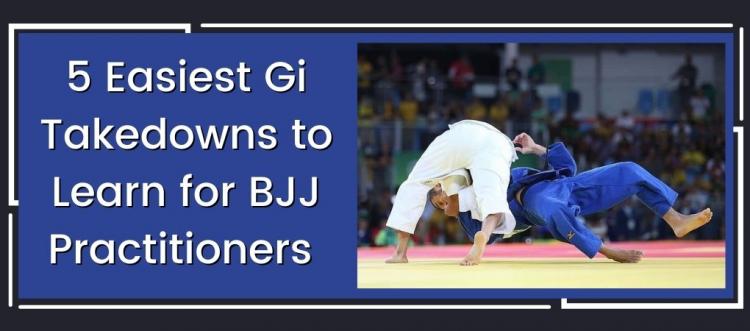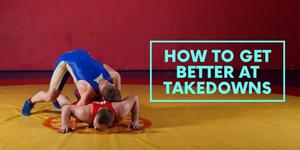Learning takedowns is an important aspect of becoming a well-rounded grappler. Fights always start standing up. You have to know how to take every fight to the ground when the opportunity presents itself.
Gi takedowns are easier to perform compared to their no-gi counterparts due to all the grips you can get a hold of on your opponents Gi. If you are new to Gi Jiu-jitsu, you have to remember: sleeves, collars, and lapels are always your first priority when trying to get grips.
In this article, we give you the 5 easiest gi takedowns to learn for BJJ practitioners. Getting opponents to the ground should not be difficult. Speed and power may give you an easier time landing those takedowns, but timing and knowing when to execute is still the foundation of every grappler’s arsenal.
And remember, LEARN AND DRILL YOUR TAKEDOWNS EVEN IF YOU ARE A BOTTOM PLAYER. You don’t want to be that guy who ends up pulling guard in a real fight because you don’t drill your takedowns.
Collar Drag
The collar drag is one of the first and simplest takedowns you will learn when you put on the Gi. It does not require too much strength or flexibility to pull off, just a bit of timing and patience. Though it is one of the most basic gi takedowns, you will see a lot of black belts still using this during training and competition.

As you progress through your BJJ journey, it is good to keep this move in your arsenal as it is a great way to surprise your opponents with every so often.
When should you use it?
You should use this takedown when your opponent is putting too much weight on you and you want to redirect his pressure. Always remember to pull perpendicular to your opponent’s feet and make sure all his weight is off you when you do so.
Why is it effective for Gi?
The collar drag is very effective with the gi due to the powerful grips you have on your opponent. With one grip on the collar and the other on your opponent’s sleeve, you create a powerful frame that your opponent has to break before they can even think of going on the offense.
Foot Sweeps
When it comes to basic takedowns directly derived from Judo, the foot sweep will be the first on the list. It is one of the easiest and most efficient ways to score a takedown, but it is also one of the most ignored. Learning foot sweeps to expand your takedown repertoire will give you more options to attack come sparring time.
When should you use it?
You should use the foot sweep when you have control of your opponent’s gi and upper body. Make sure to keep them postured high, and off the heels. Timing is the most important ingredient to successfully pulling this off. Be patient and wait for the right moment!
Why is it effective for Gi?
The foot sweep does not require a lot of strength or energy to execute. You just need to have a good grip on your opponent’s gi and make sure you catch them off guard, preferably when they are off their heels and on their toes. This move also does not put you in a bad position if your opponent manages to counter it.
Armdrag to inside trip
The arm drag is a move commonly used in wrestling but has made its way to Jiu-jitsu due to how effective it is at instantly bringing your opponent to the ground with you in passing position. The addition of the inside trip ensures you get your opponent down without them having a chance to sprawl or recover.
When should you use it?
You should use this technique when your base is lower than your opponent and you are in range of dragging their lead arm. Combo the drag with an inside trip to keep your opponent from sprawling or pulling their arm out from your grip.
Why is it effective for Gi?
Arm dragging in Gi is very effective because it gives you material to pull on. This is great because your opponent will have no chance of pulling their arm out once you get that grip on their sleeve.
Single Leg (Gi version)
The single-leg takedown is one of the most common takedowns in grappling because of how high percentage it is to pull off. This is also one of the most secure takedowns to learn in Gi as you have the material of your own gi to hold on to once you get into a single-leg position.
When should you use it?
This takedown should be done when your base is lower than your opponent and their lead leg is in range for you to immediately catch. Remember to hold onto your own gi when you get into position so it is difficult to break out of.
Why is it effective for Gi?
It is very difficult to escape someone who has got you in a single-leg position in a Gi match. This is because your opponent will have their own gi to hold on to, making it very difficult to break. Once someone catches you in a single leg, you will feel the immense pressure of your opponent crashing down on your lower body. This will instantly bring you to the ground if you don’t know how to properly defend.
Collar grip Ankle Pick
The ankle pick is another move that originated from wrestling, which has found success in Jiu-jitsu. This takedown is high percentage and easy to pull off, even for beginners. When done properly, this move forces your opponent into a single-legged stance. This gives you a better chance of dragging them to the ground.
When should you use it?
You should go for the ankle pick when you break your opponent’s posture with the collar grip. Don’t be scared to forcefully pull your opponent in as you dive to catch the ankle.
Why is it effective for Gi?
Being able to grab your opponent’s collar greatly increases the chance of getting the ankle pick. This is because of your ability to pull your opponent in while simultaneously pulling yourself forward. This will close the distance and give you the opportunity to snatch your opponent’s ankles in one go.




